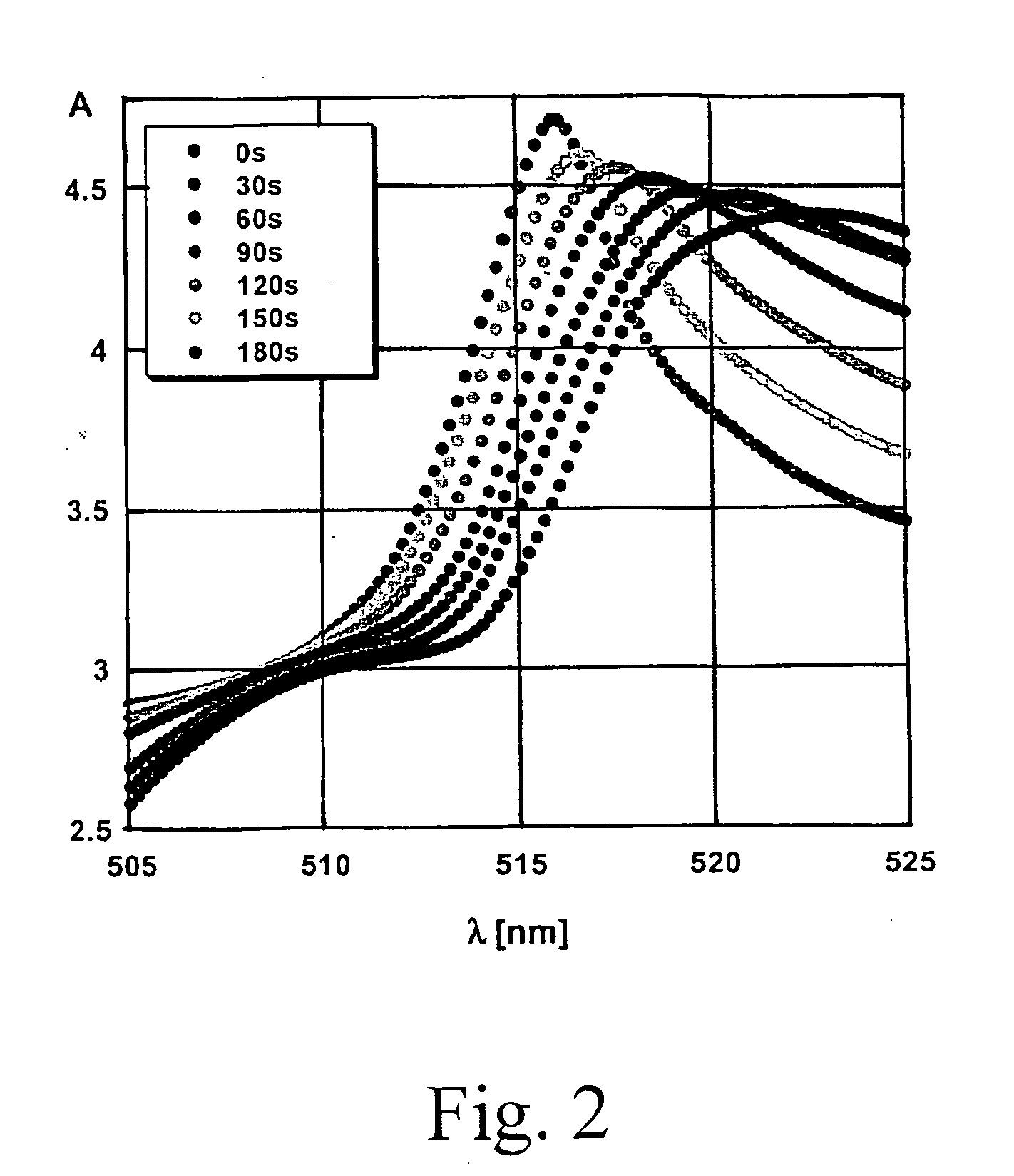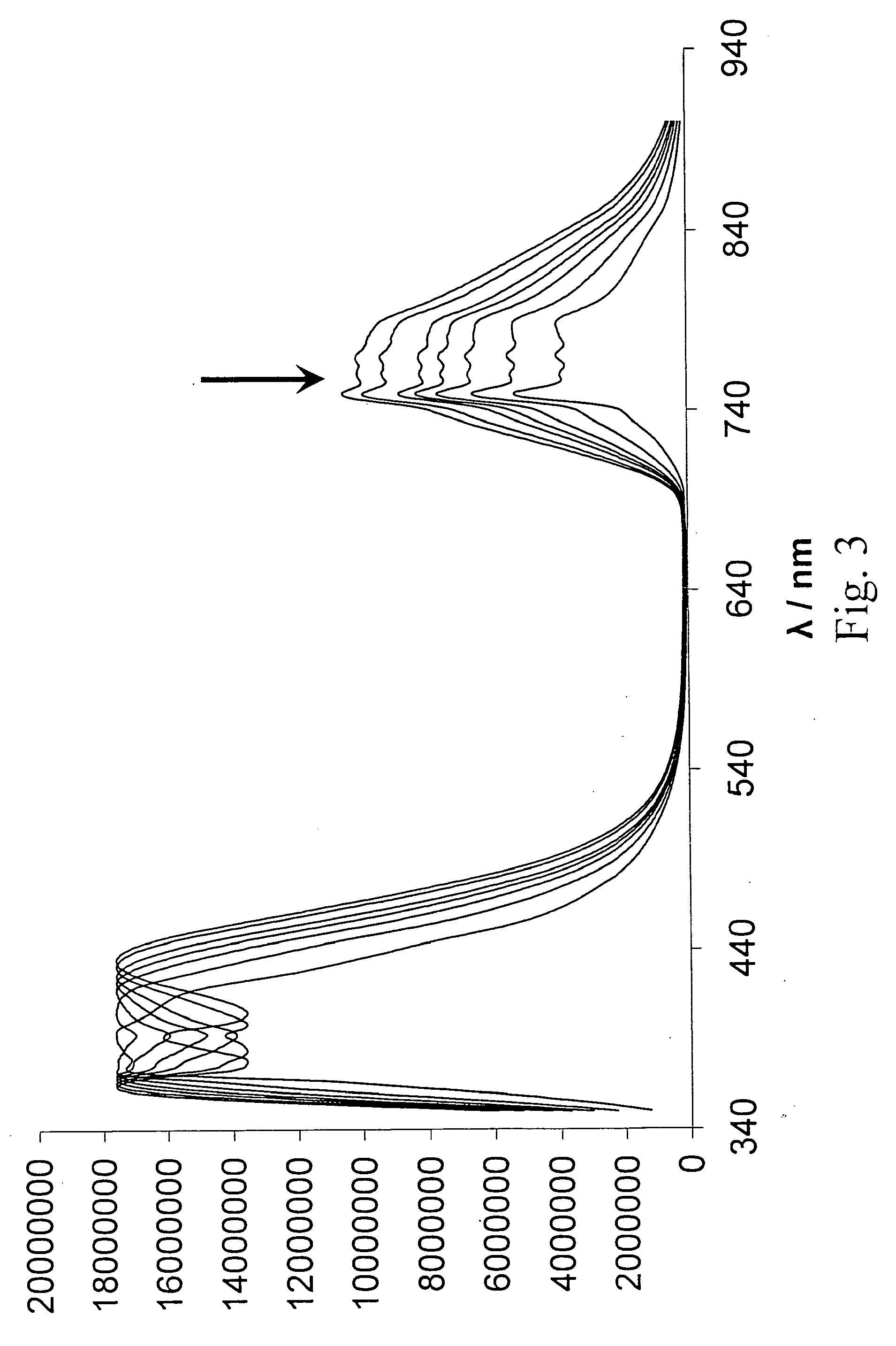Protease assay
a protease and assay technology, applied in the field of protease assays, can solve the problems of difficult diagnosis of cancer, affecting treatment efficiency, and difficult to develop treatments that separate cancer cells from healthy cells
- Summary
- Abstract
- Description
- Claims
- Application Information
AI Technical Summary
Problems solved by technology
Method used
Image
Examples
example 1
Synthesis of Nanoparticle Assembly
[0074]In this procedure, the synthesis of a nanoparticle assembly is described. The nanoparticles can be synthesized according to known methods. They are also commercially-available from various sources, for example from Nanoscale Corp. (Manhattan, Kans.) and Sigma Aldrich (St. Louis, Mo.). Suitable nanoparticles for use in the following method include freshly-prepared, non-stabilized nanoparticles, or stabilized nanoparticles. Non-stabilized nanoparticles can be stabilized using ligand exchange as described below.
1. Ligand Exchange
[0075]A first set of nanoparticles are dissolved in a non-polar or dipolar aprotic solvent and then treated with 2-aminoethanethiol under pressure (1000 psi) at room temperature for 1 hour. Alternatively, water-soluble nanoparticles can be treated with 2-aminoethanethiol in H2O / acetonitrile mixtures under pressure (1000 psi) at room temperature for 1 hour.
The surface-exchanged nanoparticles are then isolated using prepara...
example 2
Preparation of Dye Assemblies
[0081]In this procedure, the synthesis of dye assemblies is described. The consensus sequence (cleavage sequence) of the target protease is selected. The oligopeptide containing the consensus sequence for coupling the dyes is then prepared by using classic peptide synthesis (modified Merrifield synthesis), resulting in an exemplary oligopeptide as shown in Example 1. Virtually any fluorescent or phosphorescent dye is suitable for linking to the oligopeptide. However fluorescent dyes or phosphorescent metal complexes possessing a high fluorescence or phosphorescence quantum yield are more suitable. There must be an overlap between the excitation spectrum of the first dye and the fluorescence or phosphorescence spectrum of the second dye in the assembly to permit Förster Energy Transfer (see below). Examples of suitable dyes include all coumarins (especially suited to one- and multi-photon excitation), porphyrins and related compounds, fluoresceine and rel...
example 3
Nanoparticle-Nanoparticle: Absorption Spectroscopy
[0085]In this procedure, UV / Vis-Absorption spectroscopy was used to measure the activity of uPA. All chemicals and solvents were purchased from Fisher / Acros (Pittsburgh, Pa.), unless otherwise noted. A nanoparticle-nanoparticle assembly was prepared using citrate-stabilized gold nanoparticles (Sigma-Aldrich, St. Louis, Mo.) with a 10 nm diameter and an oligopeptide with the following sequence: CGGGSGRSAGGGC (SEQ ID NO: 35) (GenScript, Piscataway, N.J.). First, 1 mg of the nanoparticles was suspended in 25 ml of tetrahydrofuran (THF) containing 1.0×10−3 M of glycine. The microheterogeneous solution was heated under pressure (100 psi) and argon-atmosphere to 200° C. for 5 hours. The reaction was carried out using a High-Pressure Reactor (available from Parr Instruments, Moline, Ill.). Digestive ripening decreased the Au-nanoparticle diameter to 4-5 nm. The nanoparticles were then removed from the solution by ultracentrifugation at 30,0...
PUM
| Property | Measurement | Unit |
|---|---|---|
| diameters | aaaaa | aaaaa |
| diameter | aaaaa | aaaaa |
| diameter | aaaaa | aaaaa |
Abstract
Description
Claims
Application Information
 Login to View More
Login to View More - R&D
- Intellectual Property
- Life Sciences
- Materials
- Tech Scout
- Unparalleled Data Quality
- Higher Quality Content
- 60% Fewer Hallucinations
Browse by: Latest US Patents, China's latest patents, Technical Efficacy Thesaurus, Application Domain, Technology Topic, Popular Technical Reports.
© 2025 PatSnap. All rights reserved.Legal|Privacy policy|Modern Slavery Act Transparency Statement|Sitemap|About US| Contact US: help@patsnap.com



